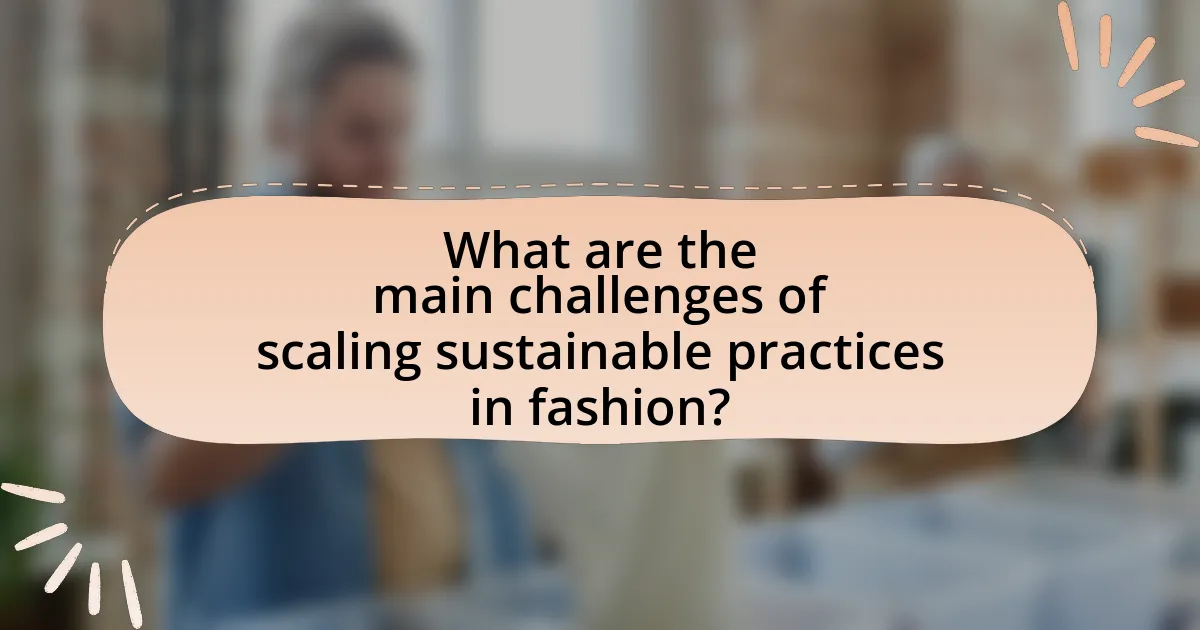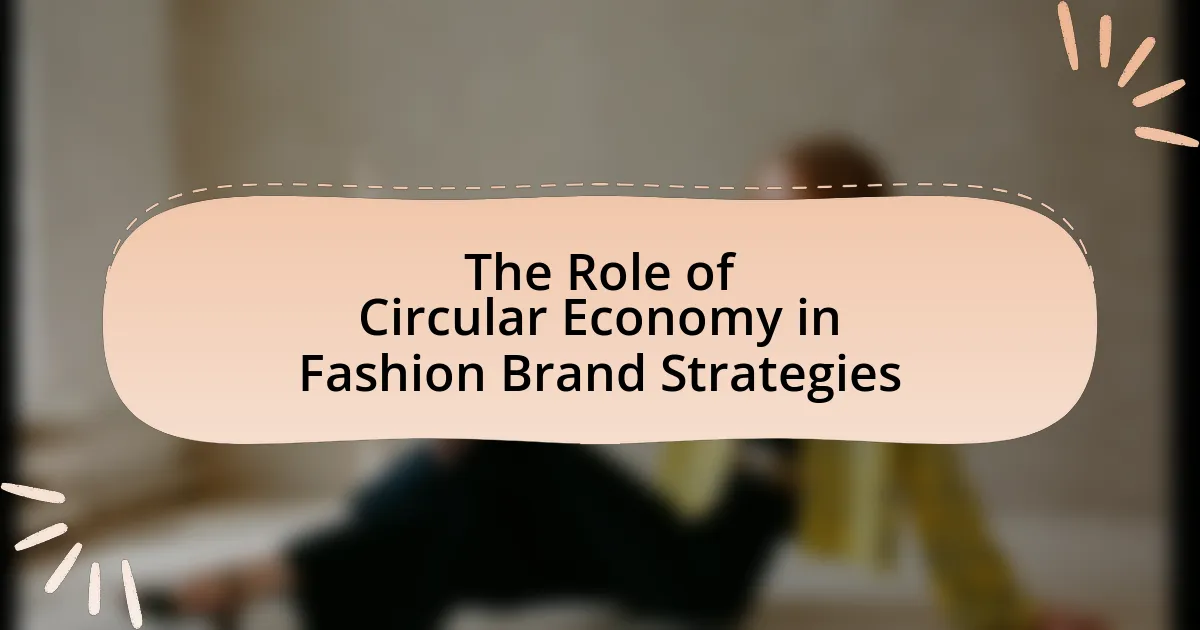The article examines the challenges of scaling sustainable practices in the fashion industry, highlighting key obstacles such as high costs, supply chain complexities, and consumer demand for fast fashion. It discusses the economic factors that influence sustainability, including investment and production costs, as well as the impact of market demands and technological barriers. Additionally, the article explores the role of regulatory frameworks, social and cultural factors, and the importance of collaboration and innovation in overcoming these challenges. It concludes with strategies for brands to effectively adopt sustainable practices and measure their impact, emphasizing the need for a structured approach to transition towards sustainability in fashion.

What are the main challenges of scaling sustainable practices in fashion?
The main challenges of scaling sustainable practices in fashion include high costs, supply chain complexities, and consumer demand for fast fashion. High costs arise from the investment needed for sustainable materials and technologies, which can deter brands from adopting these practices. Supply chain complexities involve the difficulty of sourcing sustainable materials and ensuring ethical labor practices across global networks, often leading to inconsistencies and increased operational challenges. Additionally, consumer demand for fast fashion creates pressure on brands to prioritize speed and cost over sustainability, making it difficult to implement long-term sustainable practices effectively. These challenges are supported by industry reports indicating that while 66% of consumers are willing to pay more for sustainable brands, the majority still prioritize price and convenience, complicating the transition to sustainability in the fashion sector.
How do economic factors impact the scalability of sustainable practices?
Economic factors significantly impact the scalability of sustainable practices by influencing investment, production costs, and consumer demand. High initial investments in sustainable technologies and materials can deter businesses from adopting these practices, as evidenced by a 2021 McKinsey report indicating that sustainable fashion brands often face higher production costs compared to conventional brands. Additionally, fluctuating economic conditions can affect consumer willingness to pay a premium for sustainable products, which was highlighted in a 2020 survey by Deloitte showing that only 32% of consumers prioritize sustainability when making purchasing decisions. Consequently, these economic dynamics can limit the widespread adoption and scalability of sustainable practices within the fashion industry.
What role does cost play in adopting sustainable materials?
Cost significantly influences the adoption of sustainable materials in the fashion industry. High initial costs associated with sustainable materials often deter brands from integrating them into their production processes. For instance, sustainable fabrics like organic cotton or recycled polyester can be more expensive than conventional materials, leading to increased production costs. According to a 2021 report by McKinsey & Company, 66% of fashion executives cited cost as a primary barrier to adopting sustainable practices. This financial consideration impacts not only the decision-making of brands but also the pricing strategies for consumers, ultimately affecting market demand for sustainable products.
How do market demands influence sustainable practices in fashion?
Market demands significantly influence sustainable practices in fashion by driving brands to adopt eco-friendly materials and ethical production methods. As consumers increasingly prioritize sustainability, brands respond by integrating practices such as using organic fabrics, reducing waste, and ensuring fair labor conditions. For instance, a 2021 McKinsey report indicated that 67% of consumers consider sustainability when making a purchase, prompting brands to innovate and align their offerings with these values. This shift not only meets consumer expectations but also enhances brand loyalty and market competitiveness, demonstrating the direct correlation between market demands and sustainable practices in the fashion industry.
What are the technological barriers to scaling sustainable practices?
Technological barriers to scaling sustainable practices in fashion include inadequate infrastructure, high costs of sustainable materials, and limited access to advanced technologies. Inadequate infrastructure hampers the efficient implementation of sustainable practices, as many facilities lack the necessary equipment for eco-friendly production methods. High costs associated with sustainable materials, such as organic cotton or recycled polyester, deter manufacturers from adopting these alternatives, as they often lead to increased production costs. Limited access to advanced technologies, such as automation and data analytics, restricts the ability of companies to optimize their supply chains for sustainability. These barriers collectively hinder the widespread adoption of sustainable practices in the fashion industry.
How does innovation affect the implementation of sustainable technologies?
Innovation significantly enhances the implementation of sustainable technologies by introducing new methods, materials, and processes that improve efficiency and reduce environmental impact. For instance, advancements in textile recycling technologies allow for the recovery of materials from discarded garments, thereby minimizing waste and resource consumption. According to a report by McKinsey & Company, innovative practices in the fashion industry, such as the use of bio-based materials and digital design tools, can lead to a reduction of up to 30% in greenhouse gas emissions. This demonstrates that innovation not only facilitates the adoption of sustainable technologies but also drives measurable improvements in sustainability outcomes within the fashion sector.
What challenges do brands face in integrating sustainable supply chains?
Brands face significant challenges in integrating sustainable supply chains, primarily due to high costs, lack of transparency, and limited access to sustainable materials. High costs arise from the initial investment required for sustainable practices, which can deter brands from making the transition. Lack of transparency complicates the ability to trace the origins of materials and ensure ethical practices throughout the supply chain. Limited access to sustainable materials restricts brands’ options, making it difficult to source eco-friendly alternatives. According to a 2021 McKinsey report, 66% of fashion executives cited cost as a major barrier to sustainability, highlighting the financial implications of adopting sustainable supply chain practices.
How do regulatory frameworks impact sustainable practices in fashion?
Regulatory frameworks significantly influence sustainable practices in fashion by establishing standards and guidelines that companies must follow. These frameworks can mandate environmental assessments, promote transparency in supply chains, and enforce penalties for non-compliance, thereby encouraging brands to adopt more sustainable practices. For instance, the European Union’s Green Deal aims to make the fashion industry more sustainable by implementing stricter regulations on waste management and resource use, which compels companies to innovate and reduce their environmental impact. Additionally, regulations such as the California Transparency in Supply Chains Act require companies to disclose their efforts to eradicate slavery and human trafficking, indirectly promoting ethical sourcing and sustainable labor practices.
What regulations exist to promote sustainability in the fashion industry?
Regulations promoting sustainability in the fashion industry include the European Union’s Circular Economy Action Plan, which aims to make sustainable products the norm, and the Fashion Sustainability and Social Accountability Act in New York, requiring brands to disclose their environmental impact. These regulations are designed to reduce waste, encourage recycling, and improve transparency in supply chains. For instance, the EU’s plan targets a 55% reduction in greenhouse gas emissions by 2030, directly impacting fashion production practices.
How do compliance costs affect small versus large fashion brands?
Compliance costs disproportionately burden small fashion brands compared to large ones. Small brands often operate with limited financial resources, making it challenging to absorb the high costs associated with regulatory compliance, such as environmental standards and labor laws. For instance, a study by the European Commission found that small enterprises face compliance costs that are 20% higher relative to their turnover than larger firms, which can more easily spread these costs across a broader revenue base. Consequently, small brands may struggle to maintain profitability while adhering to compliance requirements, potentially hindering their growth and sustainability efforts. In contrast, large fashion brands typically have dedicated compliance teams and greater financial flexibility, allowing them to manage these costs more effectively and invest in sustainable practices without jeopardizing their operations.

What social and cultural factors influence the scaling of sustainable practices?
Social and cultural factors significantly influence the scaling of sustainable practices in fashion by shaping consumer behavior, industry norms, and community values. For instance, consumer awareness and demand for ethical products drive brands to adopt sustainable practices, as evidenced by a 2021 survey indicating that 66% of global consumers are willing to pay more for sustainable brands. Additionally, cultural attitudes towards sustainability, such as the increasing prioritization of environmental responsibility in many societies, encourage businesses to integrate sustainable practices into their operations. Furthermore, social movements advocating for sustainability, like the Fashion Revolution movement, have raised awareness and pressured brands to adopt more sustainable practices, demonstrating the impact of collective cultural action on industry standards.
How does consumer awareness affect the adoption of sustainable fashion?
Consumer awareness significantly enhances the adoption of sustainable fashion by informing individuals about the environmental and social impacts of their purchasing decisions. When consumers are educated about issues such as pollution, labor practices, and resource depletion associated with fast fashion, they are more likely to seek out sustainable alternatives. Research indicates that 66% of global consumers are willing to pay more for sustainable brands, demonstrating a direct correlation between awareness and purchasing behavior. Furthermore, campaigns and certifications that highlight sustainable practices can influence consumer choices, leading to increased demand for eco-friendly products. This heightened awareness not only drives sales for sustainable brands but also encourages traditional fashion companies to adopt more sustainable practices in response to consumer expectations.
What role does education play in promoting sustainable fashion choices?
Education plays a crucial role in promoting sustainable fashion choices by increasing awareness and understanding of environmental impacts associated with the fashion industry. Through educational programs, consumers learn about the consequences of fast fashion, including pollution, waste, and unethical labor practices. For instance, a study by the Ellen MacArthur Foundation highlights that educating consumers about the lifecycle of garments can lead to more informed purchasing decisions, ultimately reducing demand for unsustainable products. Furthermore, educational initiatives can empower future designers and industry professionals to prioritize sustainability in their practices, fostering a culture of responsibility within the fashion sector.
How do cultural attitudes towards sustainability vary across regions?
Cultural attitudes towards sustainability vary significantly across regions, influenced by historical, economic, and social factors. For instance, in Scandinavian countries, a strong emphasis on environmental stewardship is evident, with high public support for sustainable practices, as reflected in policies promoting renewable energy and waste reduction. In contrast, regions like Southeast Asia may prioritize economic growth over environmental concerns, leading to a slower adoption of sustainable practices, despite increasing awareness of environmental issues. Research by the World Economic Forum indicates that cultural values, such as collectivism in Asian cultures versus individualism in Western cultures, further shape these attitudes, impacting consumer behavior and corporate responsibility in the fashion industry.
What impact do industry norms have on sustainable practices?
Industry norms significantly influence sustainable practices by establishing standards that companies are expected to follow. These norms can drive innovation and compliance, encouraging businesses to adopt environmentally friendly methods and materials. For instance, the Global Fashion Agenda’s 2020 report highlights that adherence to industry standards can lead to a 30% reduction in greenhouse gas emissions in the fashion sector. Furthermore, when companies align with norms such as the Sustainable Apparel Coalition’s Higg Index, they are more likely to implement sustainable practices, as these frameworks provide measurable benchmarks for environmental performance. Thus, industry norms serve as a catalyst for promoting sustainability within the fashion industry.
How do peer influences shape brand commitments to sustainability?
Peer influences significantly shape brand commitments to sustainability by creating social pressure and expectations among consumers and companies. When influential peers advocate for sustainable practices, brands often feel compelled to align their values and operations with these expectations to maintain their reputation and customer loyalty. Research indicates that brands that observe competitors adopting sustainable practices are more likely to implement similar initiatives to avoid losing market share, as seen in the fashion industry where brands like Patagonia and Everlane have set benchmarks for sustainability. This peer-driven dynamic fosters a competitive environment where sustainability becomes a critical factor in brand identity and consumer choice.
What are the challenges of changing established fashion norms?
Changing established fashion norms faces significant challenges, primarily due to entrenched consumer behaviors and industry resistance. Consumers often exhibit loyalty to familiar styles and brands, making them hesitant to embrace new trends, especially those that prioritize sustainability over aesthetics. Additionally, the fashion industry is heavily influenced by fast fashion models that prioritize rapid production and low costs, which can conflict with sustainable practices. For instance, a report by McKinsey & Company highlights that 60% of consumers prefer to buy from brands that align with their values, yet many are still drawn to cheaper, less sustainable options. This creates a paradox where the demand for sustainable fashion exists, but the willingness to change purchasing habits is limited. Furthermore, established brands may resist altering their production processes due to the perceived financial risks and potential loss of market share, making it difficult to shift towards more sustainable practices.

What strategies can be employed to overcome challenges in scaling sustainable practices?
To overcome challenges in scaling sustainable practices in fashion, companies can implement a multi-faceted approach that includes collaboration, innovation, and education. Collaboration among stakeholders, such as brands, suppliers, and consumers, fosters shared resources and knowledge, which can lead to more efficient sustainable practices. For instance, the Sustainable Apparel Coalition has brought together over 200 organizations to improve sustainability in the apparel industry through shared tools and metrics.
Innovation in materials and processes is crucial; adopting technologies like 3D printing and biodegradable fabrics can significantly reduce waste and resource consumption. A study by McKinsey & Company highlights that innovative materials can reduce the environmental impact of fashion by up to 30%.
Education and training for employees and consumers about sustainable practices can drive demand for eco-friendly products and encourage responsible consumption. Research from the Ellen MacArthur Foundation indicates that consumer awareness can lead to a 20% increase in the purchase of sustainable products.
By leveraging collaboration, innovation, and education, the fashion industry can effectively address the challenges of scaling sustainable practices.
How can collaboration enhance the scalability of sustainable practices?
Collaboration enhances the scalability of sustainable practices by pooling resources, knowledge, and networks among stakeholders in the fashion industry. When brands, suppliers, and consumers work together, they can share best practices, reduce costs, and innovate more effectively. For instance, the Sustainable Apparel Coalition, which includes over 200 organizations, has developed the Higg Index, a standardized tool that measures environmental and social sustainability, enabling companies to benchmark and improve their practices collectively. This collaborative approach not only accelerates the adoption of sustainable methods but also amplifies their impact across the industry, demonstrating that shared efforts can lead to greater scalability and effectiveness in sustainability initiatives.
What partnerships are essential for advancing sustainable fashion initiatives?
Collaborations between fashion brands, non-governmental organizations (NGOs), and technology companies are essential for advancing sustainable fashion initiatives. Fashion brands can leverage the expertise of NGOs to implement ethical practices and ensure compliance with sustainability standards. For instance, partnerships with organizations like the Sustainable Apparel Coalition provide brands with tools and metrics to measure their environmental impact. Additionally, technology companies can offer innovative solutions, such as blockchain for supply chain transparency, which enhances traceability and accountability in sustainable practices. These collaborations create a comprehensive approach to addressing the multifaceted challenges of sustainability in the fashion industry.
How can knowledge sharing among brands improve sustainability efforts?
Knowledge sharing among brands can significantly improve sustainability efforts by facilitating the exchange of best practices, innovative solutions, and resources. When brands collaborate and share insights on sustainable materials, production processes, and waste reduction strategies, they can collectively enhance their environmental impact. For instance, the Fashion for Good initiative has demonstrated that when brands share data on supply chain transparency and sustainable sourcing, they can reduce resource consumption and lower carbon emissions across the industry. This collaborative approach not only accelerates the adoption of sustainable practices but also fosters a culture of accountability and continuous improvement among participating brands.
What role does innovation play in overcoming sustainability challenges?
Innovation is crucial in overcoming sustainability challenges by providing new technologies and methods that enhance resource efficiency and reduce environmental impact. For instance, advancements in materials science have led to the development of biodegradable fabrics and recycled materials, which significantly lower waste in the fashion industry. According to a report by McKinsey & Company, innovative practices such as circular fashion and sustainable supply chain management can reduce greenhouse gas emissions by up to 45% by 2030. This demonstrates that innovation not only addresses current sustainability issues but also paves the way for long-term solutions in the fashion sector.
How can emerging technologies facilitate sustainable practices in fashion?
Emerging technologies can facilitate sustainable practices in fashion by enabling efficient resource management, reducing waste, and promoting transparency in supply chains. For instance, technologies such as artificial intelligence and machine learning optimize inventory management, leading to reduced overproduction and waste. According to a report by McKinsey, AI can help fashion companies reduce their inventory by up to 30%, significantly lowering environmental impact. Additionally, blockchain technology enhances transparency by allowing consumers to trace the origins of materials, ensuring ethical sourcing and production practices. This transparency can increase consumer trust and drive demand for sustainable products, further encouraging brands to adopt eco-friendly practices.
What innovative business models support sustainable fashion scalability?
Innovative business models that support sustainable fashion scalability include circular economy models, subscription services, and on-demand production. Circular economy models focus on recycling and reusing materials, which reduces waste and resource consumption; for instance, brands like Patagonia promote repair and resale of their products, extending product life cycles. Subscription services, such as Rent the Runway, allow consumers to access a variety of clothing without the need for ownership, thereby minimizing overproduction and waste. On-demand production, exemplified by companies like Unmade, utilizes technology to produce garments only when there is demand, significantly reducing excess inventory and resource use. These models collectively enhance sustainability by addressing key issues of waste, resource efficiency, and consumer behavior in the fashion industry.
What best practices can brands adopt to scale sustainable practices effectively?
Brands can effectively scale sustainable practices by integrating sustainability into their core business strategy. This involves setting measurable sustainability goals, such as reducing carbon emissions by a specific percentage within a defined timeframe, and regularly reporting progress to stakeholders. For instance, a study by McKinsey & Company found that companies with clear sustainability targets are 30% more likely to achieve significant improvements in their environmental impact. Additionally, brands should invest in sustainable materials and technologies, such as recycled fabrics or renewable energy sources, which can enhance their product offerings while reducing environmental footprints. Collaborating with suppliers to ensure ethical sourcing and transparency in the supply chain further strengthens sustainable practices. By adopting these best practices, brands can not only improve their sustainability performance but also meet the growing consumer demand for environmentally responsible products.
How can brands measure the impact of their sustainable initiatives?
Brands can measure the impact of their sustainable initiatives through key performance indicators (KPIs) such as carbon footprint reduction, waste diversion rates, and consumer engagement metrics. By tracking these KPIs, brands can quantify their environmental benefits and assess the effectiveness of their sustainability strategies. For instance, a study by McKinsey & Company found that companies implementing sustainability measures can reduce greenhouse gas emissions by up to 30%, demonstrating a tangible impact on environmental performance. Additionally, brands can utilize tools like Life Cycle Assessment (LCA) to evaluate the environmental impact of their products from production to disposal, providing a comprehensive view of sustainability efforts.
What are the key steps for brands to transition towards sustainability?
Brands can transition towards sustainability by implementing a structured approach that includes assessing their current practices, setting clear sustainability goals, engaging stakeholders, adopting sustainable materials, and measuring progress.
First, brands should conduct a comprehensive assessment of their existing operations to identify areas for improvement, such as resource usage and waste generation. Next, they must establish specific, measurable sustainability goals, such as reducing carbon emissions by a certain percentage within a defined timeframe. Engaging stakeholders, including employees, suppliers, and customers, is crucial for fostering a culture of sustainability and ensuring buy-in for new initiatives.
Additionally, brands should prioritize the adoption of sustainable materials and practices, such as using organic fabrics or implementing circular economy principles. Finally, measuring progress through regular reporting and audits helps brands stay accountable and make necessary adjustments to their strategies.
These steps are supported by research indicating that companies with clear sustainability strategies can enhance brand loyalty and improve financial performance, as seen in a 2020 study by McKinsey & Company, which found that 67% of consumers consider sustainability when making purchasing decisions.




